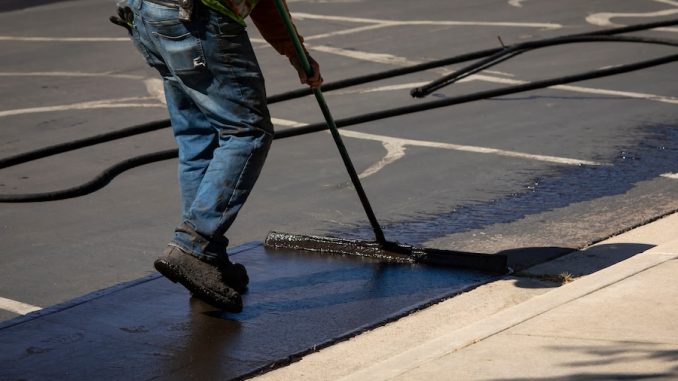
View the complete article here.
Asphalt is known for its durability, cost-effectiveness, and flexibility—making it a popular choice for paving roads, parking lots, and driveways. However, even the best asphalt surfaces require regular maintenance to remain in optimal condition. Over time, exposure to traffic, weather, and environmental factors can cause wear-and-tear—leading to cracks, potholes, and surface damage. Proactive maintenance strategies like sealing, patching, and resurfacing are key to extending the life of asphalt pavements and ensuring they remain safe and functional.
Sealing Asphalt Pavement
What is sealing?
Sealing, or sealcoating, involves applying a protective layer to the surface of the asphalt. This coating acts as a barrier against environmental elements like UV rays, water, oil, and chemicals—which can degrade the asphalt over time. By sealing the pavement, contractors can extend the lifespan of the asphalt and improve its overall appearance.
Why sealing is important:
- Prevents oxidation: Asphalt exposed to sunlight becomes brittle and prone to cracking. Sealcoating prevents UV rays from oxidizing the asphalt binder.
- Protects against water damage: Water infiltration can weaken the pavement’s foundation, leading to cracks and potholes. A seal coat minimizes the risk of water seeping into the pavement.
- Resists chemical spills: Oil, gasoline, and other chemicals can deteriorate asphalt. Sealing provides a protective layer against these substances.
When to seal:
It’s recommended to apply a seal coat every 2 to 4 years, depending on traffic volume and exposure to the elements. New asphalt should be allowed to cure for at least 6 months before sealing.
Best practices for sealing:
- Surface preparation: Ensure the surface is clean and free from dirt, debris, and oil spots before applying the sealant.
- Choose the right sealant: There are various types of sealants—including coal tar-based, asphalt emulsion, and acrylic polymer. Choose a product that suits the specific conditions of the pavement.
- Application methods: Sealing can be applied using a squeegee, brush, or spray system. The method chosen often depends on the size of the area and the type of sealant.
Patching Asphalt Pavement
Patching is the process of repairing localized areas of damage on the asphalt surface—such as potholes, cracks, or depressions. Patching is often used as a temporary solution to fix damaged areas and prevent further deterioration.
Why patching is important:
- Prevents further damage: Small cracks and holes can quickly expand into larger problems if left untreated. Patching prevents these minor issues from escalating into costly repairs.
- Improves safety: Potholes and large cracks can pose safety risks to vehicles and pedestrians. Patching helps eliminate these hazards and maintain a smooth surface.
- Reduces water infiltration: Cracks and potholes allow water to seep into the pavement’s subbase—weakening the structure. Patching seals these gaps, preventing water damage.
Types of patching:
- Throw-and-go patching: A temporary, quick fix where asphalt mix is thrown into the hole and compacted. This method is used for emergency repairs but isn’t a long-term solution.
- Semi-permanent patching: Involves cleaning the damaged area, applying an asphalt mix, and compacting it to match the existing pavement level. This method is more durable than throw-and-go patching.
- Full-depth patching: For deep, extensive damage—full-depth patching removes the damaged asphalt and subbase, replacing it with new material. This is the most durable patching method and provides a long-term fix.
Best practices for patching:
- Clean the area: Remove all loose debris, dirt, and water before applying the patching material.
- Use quality materials: Choose high-quality asphalt mix for patching to ensure a durable and long-lasting repair.
- Proper compaction: After applying the patch, make sure it is compacted properly to match the surrounding pavement and avoid creating weak spots.
Resurfacing Asphalt Pavement
Resurfacing, also known as overlaying, involves adding a new layer of asphalt to the existing pavement. This method is used when the surface is significantly worn but the underlying structure is still sound. Resurfacing can extend the life of the pavement by providing a fresh, smooth layer on top of the old one.
Why resurfacing is important:
- Restores appearance and smoothness: Resurfacing rejuvenates the pavement by eliminating surface imperfections, creating a smooth and uniform surface.
- Prolongs pavement life: By applying a new layer of asphalt, resurfacing helps reinforce the pavement structure—delaying the need for complete replacement.
- Cost-effective: Resurfacing is less expensive than full-depth reconstruction, making it an attractive option for addressing widespread surface wear.
When to resurface:
Resurfacing is typically recommended when the asphalt has widespread cracking, rutting, or unevenness but the base and subbase remain stable. Pavements that have been regularly maintained through sealing and patching are good candidates for resurfacing, as they often retain structural integrity longer.
Best practices for resurfacing:
- Evaluate the pavement condition: Before resurfacing, contractors should assess the pavement’s subbase to ensure it is still stable and capable of supporting a new layer.
- Proper surface preparation: Clean the existing surface and fill any cracks or holes before laying the new asphalt layer.
- Thickness considerations: The thickness of the overlay is important, typically between 1.5 to 2 inches for driveways or parking lots. Too thin, and it won’t last—too thick, and it may not bond properly to the old surface.
Conclusion
Maintaining asphalt pavement through sealing, patching, and resurfacing is essential for extending its lifespan and ensuring safe, durable surfaces. Sealing protects the surface from environmental damage, patching addresses localized areas of deterioration, and resurfacing restores the pavement’s appearance and strength.
View the complete article here.
How often should asphalt pavement be sealed?
Asphalt should be sealed every 2 to 4 years, depending on traffic volume and exposure to the elements. When is resurfacing necessary for asphalt pavement?
Resurfacing is recommended when the surface shows widespread cracks or rutting, but the underlying structure remains stable.













































